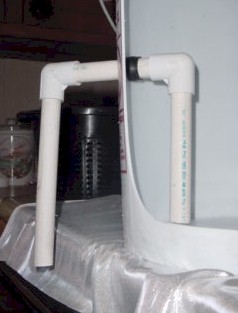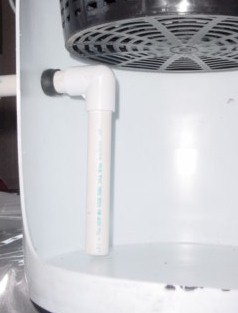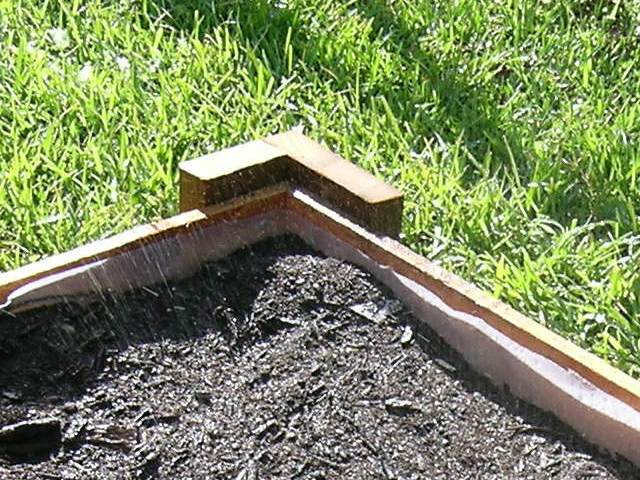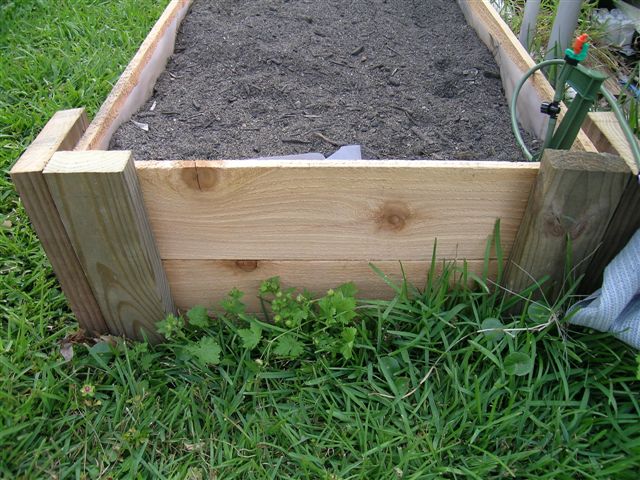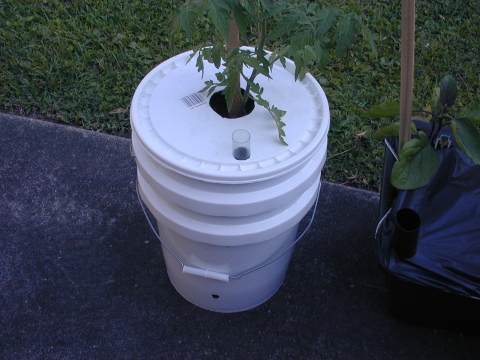These originally appeared on a now-defunct hydroponics website, and show how the hydro gardener assembled Dutch pot -style hydro containers from 5-gallon buckets, PVC pipe, and 10" net pots. The grommet used is a 3/4", the drilled hole for it is 7/8" (rather than 13/16), allowing 3/4" PVC pipe to pass thru and seal snugly. The drilled hole should be positioned so that it will be about 1" below the bottom of the installed net pot. Chamfering the end of the PVC pipe and lubricating it with soapy water facilitated inserting the pipe through the grommet. The grommet shown is not the standard doughnut shape, but rather a T shape, with the insertion of the pipe expanding the inner side of the grommet to effect the seal. The inside end of the drain pipe should be cut at an angle to help prevent clogging. Note that the photos showing the buckets installed appear to have their drains cut and spliced to lengthen some of them, because the grade of the main drainpipe was not considered. The grow medium appears to be pea gravel, with nutrients fed via drip emitters from a main supply line. Note that it's a good idea, no matter where you place the emitter, that the connection to the supply line be over the bucket as well, in case of leaks.
Category: Projects
Building an NFT System

Building this 30 plant site NFT system was challenging, and a lot of fun. Finding all the necessary components was the challenging part; putting it together and having it work was the fun.
Basically, it's three channels, or gulleys, fed by a submersible pump in a reservoir. Water is pumped up through a manifold which supplies the jet pipes in each gulley. Water flowing along the bottom of the gulleys and splashing on the net pots keeps the plant roots moist, nourished, and oxygenated.
Each gulley is a 4"x4"x6ft vinyl fence post jacket with caps for same glued and sealed onto each end. Holes are drilled for the plant sites, the drain, a drain access port, and a pass-through for the spray lines.
The reservoir itself supports the gulleys on one end, and a saw-horse type structure, the other. Holes are cut in the reservoir's lid for the gulley drains, the supply line from the pump, and an access port to check the water level and refill.
Other parts and fittings include:
- Female hose bib to 1/2" compression elbows to attach 1/2" CPVC capped-end spray bars to the manifold
- Plastic C clip brackets, bolts & nuts to attach spray bars to upper inside of gulleys
- 3/4" PVC Ts and elbows to fabricate manifold (slip x slip x thread)
- 3/4"NPT x male hose thread nipples to attach compression elbows to manifold
- 1-1/4" x 9" plastic lavatory drain pipes for gulley drains
- Various grommets for drain pipe and spray bar seals
- 750 gph magnetic drive submersible pump
- 3" net pots and hydroton expanded clay media
It would have been better to construct the unit using 5"x5" fence post jackets, but none were locally available. Using such would have allowed standard 4" diameter test plug caps to cover the drains, and would also have required the manifold to be constructed using 1" PVC fittings with 3/4" threaded outlets. I would also, in retrospect, have done better to pass the ends of the spray lines all the way through the other end cap, and terminate them with threaded caps, which would have allowed for easy cleaning with a long, thin tubing brush.
Raised Bed Garden
Not abandoning hydroponics by any means, I decided to try to go organic this season with a raised bed. I built mine 2 ft. by 12 ft. to go along the edge of a patio.
Construction, after a bit of design brainstorming, was fairly straightforward, and I was filling it up with soil in about an hour and a half.
I used 6'x5.5"x5/8" cedar fenceboards. Corners are pressure treated 12" 2x4s screwed perpendicular to 12" 2x6s. Bottoms of 2x6s have 3/8" holes drilled 5" deep into which 12" 3/8" re-bar is inserted. These will serve to stake the box to the ground. Due to the 12 ft. length, center supports made of 12" 2x6s, again with the re-bar, tie the 6 ft. sections together in the middle. There's some very minor bowing at the middle, so I may or may not add something across the top, front to back, to pull it in line. 1-1/4" galvanized screws attach ends of cedar boards to insides of corners and center connectors, 1" down from tops of corner pieces so another layer can be stacked on top later if desired. 6 mil plastic sheeting lines the inside walls, but not the bottom-- two layers of heavy cardboard are laid out in the bottom to shut out the grass.
The local organic nursery delivered a yard and a half of organic garden mix in a super sack. Really nice stuff, and with the surplus, I'll have enough to beef up the beds in front of the house and fill another 6x6 foot raised bed . Plus, I have the compost pile going since last summer, and a worm bin that puts out some really good stuff for fertilizer.
Greenhouse
My container garden project this spring would have gone a lot better except for two things. One, a weeklong period of hot sun with no rain really took a toll on the tomato plants, even though I set up a system to spray mist the foliage. Second, at some point, the critters started finding my plants-- I must have thrown out over a dozen affected tomatoes. Having my plants in a greenhouse would have-- or should have-- solved both of these problems. With the embarkation on my hydroponic system, I decided to construct a small greenhouse.
I found plans on the internet for a simple structure using PVC pipe to create a quonset hut-shaped "hoop house". Covered with 6 mil clear polyethylene film and strategically placed shade cloth, it should keep out critters, control temperature, and help retain moisture. ...continue reading "Greenhouse"
5-gallon Bucket Tomato Container Project
I came up with an idea to use a couple of 5-gallon plastic buckets to approximate an Earthbox-type planter. The buckets happen to stack with about 4 inches of space between the bottoms of the two. This space will serve as a water reservoir.
I cut a 3-1/2-inch hole in the bottom of one bucket, as well as 16 3/8" holes for soil aeration. A 16-ounce plastic Solo or Dixie cup placed in the hole serves as the "wick" for the potting mix to absorb water. Cutting slits in it allows the water to pass through.
The only mod to the lower/outer bucket was to drill a 3/8" hole in the side just below the bottom edge of the upper/inner bucket, to serve as an overflow and to allow air in. One of the 3/8" holes near the edge of the inner bucket was enlarged to accept a length of 1" rigid plastic aquarium tube for a water fill tube. I purchased a single bucket lid, in which I cut a 3" hole in the center for a single tomato plant, and also a 1" hole to accomodate the watering tube. Before putting the lid on, I spread about a cup of granular fertilizer in a thin ring around the outer edge of the surface of the potting mix. Then the lid was put on and the tomato plant was planted thru the center hole. Should be enough to sustain a single plant for an entire season.
Project cost: Buckets $2.50 (x2); lid $.97; 1"x18" tube $1.50; plastic cup free; 25 dry quarts potting mix $2.99; 1 cup dry fertilizer and 1 cup hydrated lime (to condition soil for tomatoes) ~ $.50. Total approx. $11.00.



